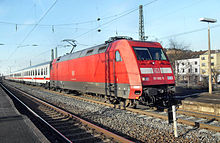Integrated overall drive
Integrated total drive , abbreviated IGA , is a single-axle drive developed by ABB for electric and diesel locomotives . It is a hollow shaft drive in which part of the weight of the travel motor is carried directly by the vehicle body.
history
During the development of the modern locomotives with three-phase drive technology, work was carried out not only on revising the electrical system but also on improving the mechanical properties of the axle drive. The focus was on a better flow of power; In all electric drives of conventional design, the drive pinion of the traction motor is on the rotor shaft outside the end shield on the drive side, which leads to high bending loads on the pinion and the motor shaft. With the integrated overall drive, the motor only has one bearing on the non-drive side, while the other end of the rotor shaft is supported by a bearing in the gear housing that is located outside the pinion and is flanged to the motor.
This drive was installed for the first time in the 120 004 and has been tested since 1993. The drive was then used in the class 101 locomotives and in some foreign locomotives and had good driving characteristics even at high speeds. The three-phase AC technology made it possible to make the motors much smaller.
technology
The integrated overall drive is used for vehicles with speeds over 140 km / h, where the masses in the bogie must be kept as small as possible so that the moments of inertia are as small as possible when rolling around the pivot point of the bogie. The ICE 2 and all other faster electric locomotives are equipped with this type of drive. The power flow is traction motor-motor pinion-intermediate gear-large gear-cardan joints-hollow shaft-cardan joints-wheel disc-rail. The intermediate gear in the transmission enables higher gear ratios and increases the distance between the motor and the axle, so that brake disks for disc brakes could be arranged on the hollow shaft .
Through its use, the maintenance intervals of the locomotives could be extended significantly, it is spoken of mileages of over 2 million kilometers. While axles and motors could still be exchanged in the railway depot with conventional drives , this is no longer possible with the integrated overall drive . The compact design requires special tools and special machines, so that only the entire drive can be replaced in the railway depot. The repair shop is responsible for further work up to now .
application
- DB class 101 express locomotive
- Railcar ICE 2
- NJT ALP-46 and ALP-45 DP
- FS E.405 and E.412
- OSE 220 (DE 2000)
patent
- Patent DE4137234 : Drive unit for rail vehicles. Registered on November 13, 1991 , published on May 19, 1993 , applicant: ABB Patent GmbH, inventor: Lutz Schwendt.
literature
- Karl Gerhard Baur: Class 101 . GeraMond Verlag GmbH, Munich 2013, ISBN 978-3-86245-188-3 , p. 29-45 .
Web links
Individual evidence
- ↑ Andreas Steimel: Electric traction vehicles and their energy supply: Basics and practice . Oldenbourg Industrieverlag, 2006, ISBN 978-3-8356-3090-1 , p. 53 ( google.cz ).
- ^ Karl Gerhard Baur: Class 101 . GeraMond Verlag, Munich 2013, ISBN 978-3-86245-188-3 , p. 33.
- ^ Karl Gerhard Baur: Class 101 . GeraMond Verlag, Munich 2013, ISBN 978-3-86245-188-3 , p. 36.
